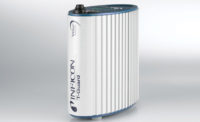Leak detection is a highly effective method for revealing potential equipment hazards.
Helium leak testing is a nondestructive form of testing and is performed via a helium mass spectrometer, or an instrument commonly used to detect and locate small leaks. Vacuum testing is done by connecting the test object to the leak detector, removing the object and then spraying helium around it.
Pressure testing is completed by pressurizing the internal volume of the object to be tested. The object is then examined for leaks with a probe connected to the leak detector. Read on to learn about the newest innovations in the leak testing field.

The touch-screen GUI allows for greater system control and monitoring during system startup and operation. Source: VIC Leak Detection
The GUI allows the operator to quickly calibrate the system with the MS-60s built-in leak standard, and perform and view a leak rate in standard view or Big Mode for viewing the panel at a distance. A Chart Mode enables an operator to simultaneously view a strip chart of leak rate, range and set point at a glance. System Diagnostic Mode enables one to monitor several operating parameters, while system set-up screens allow the operator to set up to view all system parameters including crossover points, units of measurement, delays, zero point, amp gain and spec tube function.

The Qualitek mR is a single channel tester designed for high-volume industrial leak and flow testing applications Source: Uson
The touch-screen color graphics display and easy-to-navigate PC style are combined with a rotary scroll and click navigation device. Qualitek mR features built-in pressure plots and statistics, data storage, compensation and calibration, and a pop-up soft keyboard to facilitate program editing.
This leak tester has comprehensive communication options with two USB ports, serial communications port, Ethernet and expandable digital input/output.
The Qualitek mR is a single channel tester designed for high-volume industrial leak and flow testing applications such as gas control valves, plastic reservoirs, faucets, automotive lamps and components, medical devices and packaging. A NEMA 12 rated enclosure protects the Qualitek mR, which is situated as standard on adjustable stand, and may be removed for machine mounting and integration if required.

Interlaken’s modular production leak testing systems can be integrated into production lines and workcells or can be used alone. Source: Interlaken Technology Corp.
Typical applications include fuel system components such as rails, lines and pumps. Many more applications have been identified in HVAC, aerospace and defense. Standard systems are available for pressures up to 100,000 pounds-per-square-inch. This allows companies to find leaks on high-pressure components in-house during quality control checks that were not previously discovered with testing done at less than operational pressures.
The system can be configured with custom, quick-change fixtures for high-volume production or with more universal configurations for research and development work.
There are many sensor technologies available such as pressure decay, vacuum decay and mass flow. Interlaken integrates the appropriate sensor technology and can incorporate such capabilities as data collection and analysis, part marking and material handling. Interlaken’s control module can communicate with other shop floor control systems via Ethernet, ProfiBus or CanBus.

The M1075Y leak detector family offers an array of features, including input/output control of solenoid valves. Source: InterTech Development Co.
The detectors have real-time display of all leak test stages and data storage in buffer for up to 1,000 test records, as well as a quick interchange of test sequences for multiple product testing and a Wi-Fi option.
Pfeiffer Vacuum’s (www.pfeiffer-vacuum.com) SmartTest, a wireless, remote-controlled helium leak detector, gives fast, reliable results, low detectable leak rates and short recovery time.
The RC 500 WL remote control enables an operator to control the process, and all functions can be remote operated up to 100 meters. The measured values can easily be displayed on the 3.5-inch touch screen and stored in an internal memory of the remote control. The detector features the sensitivity in identifying even the smallest leaks; can quantify the leaks; has reproducibility of the measurement and short measurement times.
Ulvac Technologies Inc.’s (www.ulvac.com) automatic leak testing (ALT) systems-including the Heliot 700 leak detector-employs Ulvac pumps, valves and gages throughout. The ALT systems are modular in design with most of the major components being manufactured by Ulvac. This modular approach to design enables customization of the system to individual customer requirements, while maintaining as many standard components as possible, providing optimum performance and support.
Air-to-air cycling of the ALT system is automatic; components are placed in a vacuum chamber, charged with helium and the chamber is evacuated. A mass spectrometer-based helium leak detector is used to measure a total leak rate for the components to check all leak points to guarantee product quality. Pump systems are sized to evacuate both chamber and test part to a suitable pressure within a short period of time to meet the requirements of desired machine cycle time.
The leak detector used is the proven Heliot 700 with a sensitivity to detect helium leaks as small as 1 by 10E-12 millibar-liters-per-second. The factory automation interface with the ALT system can be engineered and supplied by Ulvac as well for integration into the production line. Each system is equipped with a modem link so that system software troubleshooting can be done remotely by a telephone to the Ulvac service center. This capability is useful in enabling remote assistance for faultfinding and completing software changes with minimal delays in a production setting.

